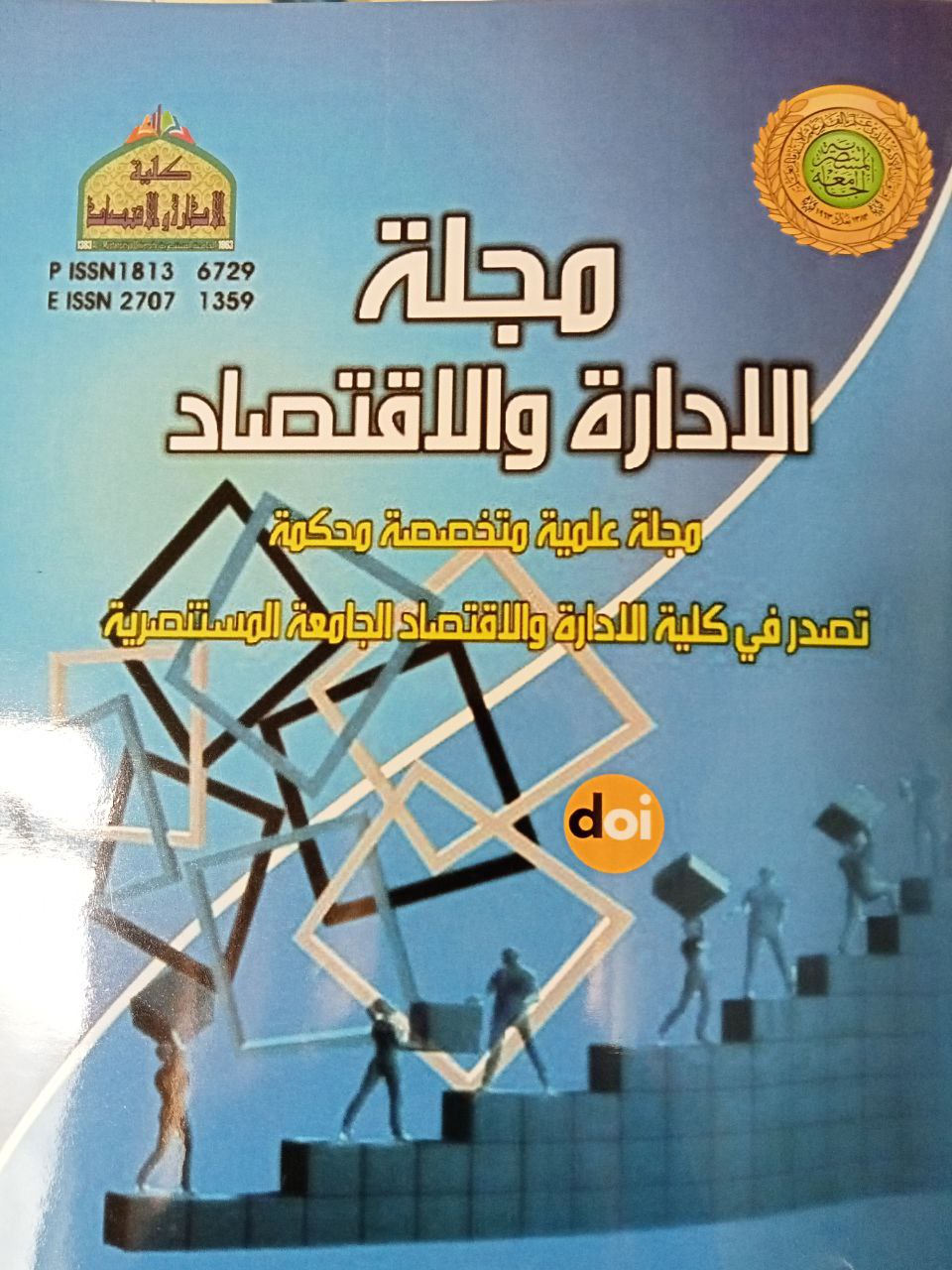دور مرونة تكنولوجيا المعلومات في تعزيز القدرات الديناميكية دراسة استطلاعية
DOI:
https://doi.org/10.31272/jae.i147.1374الكلمات المفتاحية:
تكنولوجيا المعلومات، القدرات الديناميكية، الاحصاء الوصفي، الاستدلالالملخص
يتزايد اهتمام منظمات الاعمال بمرونة تكنولوجيا المعلومات لاكتساب ميزة تنافسية مستدامة في ظل التغير المستمر لبيئة الاعمال , وهذا ما يحتم عليها بناء او اعادة بناء قدرات ديناميكية تتسم بالقوة التي تمكنها من الوصول الى التميز والريادة في مجال اعمالها, و يهدف البحث الحالي الى بيان علاقة الارتباط والتأثير بين المتغير المستقل المتمثل بمرونة تكنولوجيا المعلومات وابعادها (التوافق ، الاتصال ، النمطية) و المتغير التابع المتمثل بالقدرات الديناميكية و ابعادها (قدرات استشعار الفرص , قدرات التنسيق , قدرات التعلم , قدرات اعادة تشكيل الموارد ) على المستوى الكلي و على مستوى الابعاد في المركز الوطني لعلاج وبحوث السكري و المركز الوطني لبحوث و علاج امراض الدم و تضمنت عينة البحث الإدارة العليا و التنفيذية على مستوى المركزيين البحثيين و استخدمت الاستبانة كأداة رئيسة لجمع البيانات, اذ تم توزيع 90 استبانة استرجعت منها (85) استبانة كانت (80) استبانة صالحة للتحليل الاحصائي, وقد استعملت مجموعة من الأساليب الإحصائية المتمثلة بالإحصاء الوصفي فضلاً عن الأساليب الإحصائية الاستدلالية المتمثلة باختبار ( t ) واختبار( F ) ، و بينت نتائج تحليل الانحدار البسيط لفرضيات التأثير وجود تأثير ذو دلالة معنوية لمرونة تكنولوجيا المعلومات على المستوى الكلي في القدرات الديناميكية للمركزيين البحثيين، اما على مستوى الابعاد فكان بعد النمطية اكثر الابعاد من بين ابعاد المتغير المستقل تأثيراً في المتغير التابع .
التنزيلات
المراجع
[1] Crowston, K., & Kammerer, E. E. (1998). Coordination and collective mind in software requirements development. IBM Systems Journal, 37(2), 227-245. DOI: https://doi.org/10.1147/sj.372.0227
[2] Han, J. H., Wang, Y., & Naim, M. (2017). Reconceptualization of information technology flexibility for supply chain management: An empirical study. International Journal of Production Economics, 187, 196-215 DOI: https://doi.org/10.1016/j.ijpe.2017.02.018
[3] Ismail, A. R. (2009). Assessing the relationship between the Internet, radio frequency identifier (RFID), and information technology (IT) flexibility: a correlational study and findings. Capella University.
[4] Jantunen, A., Tarkiainen, A., Chari, S., & Oghazi, P. (2018). Dynamic capabilities, operational changes, and performance outcomes in the media industry. Journal of Business Research, 89, 251-257. DOI: https://doi.org/10.1016/j.jbusres.2018.01.037
[5] Jorfi, S., Nor, K. M., & Najjar, L. (2011). The relationships between IT flexibility, IT-Business strategic alignment, and IT capability. International Journal of Managing Information Technology, 3(1), 16-31. DOI: https://doi.org/10.5121/ijmit.2011.3102
[6] Kindström, D., Kowalkowski, C., & Sandberg, E. (2013). Enabling service innovation: A dynamic capabilities approach. Journal of business research, 66(8), 1063-1073. DOI: https://doi.org/10.1016/j.jbusres.2012.03.003
[7] Mikalef, P., & Pateli, A. (2017). Information technology-enabled dynamic capabilities and their indirect effect on competitive performance: Findings from PLS-SEM and fsQCA. Journal of business research, 70, 1-16. DOI: https://doi.org/10.1016/j.jbusres.2016.09.004
[8] Ness, L. R. (2005). Assessing the relationships among IT flexibility, strategic alignment, and IT effectiveness: study overview and findings. Journal of Information technology management, 16(2), 1-17.
[9] Pavlou, P. A., & El Sawy, O. A. (2011). Understanding the elusive black box of dynamic capabilities. Decision sciences, 42(1), 239-273 DOI: https://doi.org/10.1111/j.1540-5915.2010.00287.x
[10] Quinn, R & Dutton, J. (2005). “Coordination as energy-in-conversation: A process theory of organizing”. Academy of Management Review, 30(1): 38-57. DOI: https://doi.org/10.5465/amr.2005.15281422
[11] Shuen, A., Feiler, P. F., & Teece, D. J. (2014). Dynamic capabilities in the upstream oil and gas sector: Managing next generation competition. Energy Strategy Reviews, 3, 5-13. DOI: https://doi.org/10.1016/j.esr.2014.05.002
[12] Teece, D. J. (2017). Dynamic capabilities and (digital) platform lifecycles. In Entrepreneurship, innovation, and platforms (Vol. 37, pp. 211-225). Emerald Publishing Limited. DOI: https://doi.org/10.1108/S0742-332220170000037008
[13] Zahra, S & George, G. (2002). “Absorptive capacity: A review, reconceptualization, and extension”. Academy of Management Review, 27 (2): 185-203. DOI: https://doi.org/10.5465/amr.2002.6587995

التنزيلات
منشور
الرخصة
الحقوق الفكرية (c) 2025 حيدر عبد المحسن مجباس، نهضة علي عباس

هذا العمل مرخص بموجب Creative Commons Attribution 4.0 International License.
مجلة الإدارة والاقتصاد هي مجلة مفتوحة المصدر حيث تكون جميع محتوياتها مجانية. تخضع مقالات هذه المجلة لشروط ترخيص المشاع الإبداعي المنسوب إلى المؤلف (CC-BY 4.0) (https://creativecommons.org/licenses/by/4.0/legalcode) الذي يسمح للمرخص لهم دون قيود بالبحث عن النص الكامل للمقالات أو تنزيله أو مشاركته أو توزيعه أو طباعته أو ربطه به، وفحصه للفهرسة وإعادة إنتاج أي وسيلة للمقالات بشرط أن ينسبوا إلى المؤلفين الفضل في ذلك (الاستشهاد). تسمح المجلة للمؤلفين بالاحتفاظ بحقوق الطبع والنشر لمقالهم المنشور.
. Creative Commons-Attribution (BY)









